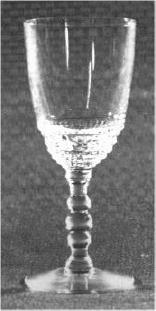National Depression Glass Association
Preserving America's Glass Manufacturing Heritage
Teardrop and the Duncan Ensemble Plan
by Gail Krause
Rainbow Review Glass Journal - November 1976
One of the most complete lines of glassware made by the Duncan and Miller factory was Teardrop. The outstanding quality of this fine handmade crystal and dinnerware made the pattern a favorite while the plant was in existence and with collectors today.
This beautiful rock crystal glassware could withstand hot drinks and
foods as the glass was annealed, but, of course, could not be placed in
the oven. The breakage rate was higher on cups than any other pieces of
 ware, making these items one of the scarcer articles in this particular
line. The cups were designed with two different handles, one being open
while the other was a solid round ball. This same rule applied to the
cream and sugar and also to the demitasse cup. The solid handle was
made earlier and was not as convenient to hold as the open one, which
probably accounts for the change.
ware, making these items one of the scarcer articles in this particular
line. The cups were designed with two different handles, one being open
while the other was a solid round ball. This same rule applied to the
cream and sugar and also to the demitasse cup. The solid handle was
made earlier and was not as convenient to hold as the open one, which
probably accounts for the change.
There were pieces made to fit any occasion and Duncan and Miller designed a program called "The Duncan Ensemble Plan," which proceeded to be very popular and would account for the many complete sets of dinnerware found today. The pattern was first chosen on the basis of beauty and good taste and in accordance with the customer's need. The pieces most frequent used would be purchased first, and others as the need and budget would permit. The most important factor would be that the pattern would be available later on. They had some of their patterns listed as "open stock." This would not be particularly true today, but during the thirties when this plan was introduced, this term was widely used in their advertisements. Their future predictions came true as we can well prove, as Teardrop is still one of the most popular patterns collected today.
This particular plan was not designed for all the fine patterns made by Duncan, only with those which had the complete line. Approximately sixty-six pieces of Teardrop were made and included 9½" casseroles, elaborate candlesticks and even the individual ashtray. In fact Duncan and Miller Company included the gentleman and had "His" Ensemble which consisted of:
- One 16 oz. decanter
- Two 2 oz. whiskey glasses
- One 5" ashtray
"Her" Ensemble for a bridge luncheon would consist of the following:
- Four 7½" dessert plates
- Four 9" water goblets
- Two 6" nut or candy compotes
- One 3-piece Lazy Susan - an 18" plate and a 6" fruit compote on a turntable
The lazy Susan wee a very versatile piece and quite popular as the hostess could serve at the table and eliminate many trips to the kitchen.
Duncan and Miller were far advanced in their thoughts and in selling as they were among the first to coordinate their tableware and silver. The Ensembles could be acquired in other patterns such as First Love and Adoration which harmonized with 1847 Rogers Bros. Silverplate having the same names. This plan is fairly common today but at the time, Duncan started this program it was a relatively new idea. The "Ensemble Plan" stressed the fact that there had not been a method to buying in the past and the need to have a full set accumulated was their prime intention. These plans were designed to be bought for a period of time, rather than acquiring the complete set at once.
The Teardrop pattern was designed for traditional furniture styles such as Duncan Phyfe, Hepplewhite, Louis XVI or Sheraton. Whatever your particular style seems to be goes well with this pattern. The tableware is called No. 301, while the lead blown crystal is known as No. 5031, the tumblers No. 5300 pattern.